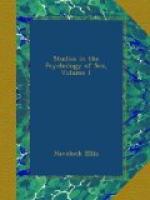as the exaggeration of a physiological state connected
with sexual conditions, more specifically with
the preparation for maternity. Hysteria is
so frequently associated with anaemic conditions
that Biernacki has argued that such conditions really
constitute the primary and fundamental cause of
hysteria (Neurologisches Centralblatt,
March, 1898). And, centuries before Biernacki,
Sydenham had stated his belief that poverty of the
blood is the chief cause of hysteria.
It would be some confirmation of this position if we could believe that chlorosis, like hysteria, is in some degree a congenital condition. This was the view of Virchow, who regarded chlorosis as essentially dependent on a congenital hyoplasia of the arterial system. Stieda, on the basis of an elaborate study of twenty-three cases, has endeavored to prove that chlorosis is due to a congenital defect of development (Zeitschrift fuer Geburtshuelfe und Gynaekologie, vol. xxxii, Part I, 1895). His facts tend to prove that in chlorosis there are signs of general ill-development, and that, in particular, there is imperfect development of the breasts and sexual organs, with a tendency to contracted pelvis. Charrin, again, regards utero-ovarian inadequacy as at least one of the factors of chlorosis. Chlorosis, in its extreme form, may thus be regarded as a disorder of development, a sign of physical degeneracy. Even if not strictly a cause, a congenital condition may, as Stockman believes (British Medical Journal, December 14, 1895), be a predisposing influence.
However it may be in extreme cases, there is very considerable evidence to indicate that the ordinary anaemia of young women may be due to a storing up of iron in the system, and is so far normal, being a preparation for the function of reproduction. Some observations of Bunge’s seem to throw much light on the real cause of what may be termed physiological chlorosis. He found by a series of experiments on animals of different ages that young animals contain a much greater amount of iron in their tissues than adult animals; that, for instance, the body of a rabbit an hour after birth contains more than four times as much iron as that of a rabbit two and a half months old. It thus appears probable that at the period of puberty, and later, there is a storage of iron in the system preparatory to the exercise of the maternal functions. It is precisely between the ages of fifteen and twenty-three, as Stockman found by an analysis of his own cases (British Medical Journal, December 14, 1895), that the majority of cases occur; there was, indeed, he found, no case in which the first onset was later than the age of twenty-three. A similar result is revealed by the charts of Lloyd Jones, which cover a vastly greater number of cases.
We owe to Lloyd Jones an important contribution to the knowledge of chlorosis in its physiological




